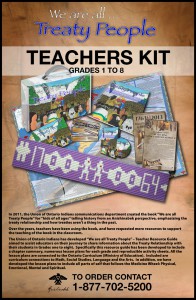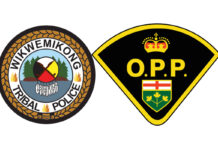Education a key element to redressing the past and building the future
EDITOR’S NOTE: The 94 recommendations of Canada’s Truth and Reconciliation Commission (TRC), chaired by Justice Murray Sinclair, were contained in the executive summary delivered to the federal government on June 2, 2015. The 300-page executive summary precedes the delivery of the full six volume TRC report, which is anticipated for delivery later this summer after being translated into a number of First Nation, Metis and Inuit languages. This article is the second instalment of a series that will delve into the key recommendations of the TRC grouped into the categories of justice, education, health, an Aboriginal Languages Act and appointment of a language commissioner, the creation of a national council of reconciliation and an annual ‘State of Aboriginal Peoples Report’ to be delivered by the sitting prime minister, the creation of a public inquiry into missing and murdered aboriginal women, as well as funding for the creation institutions, holidays and a National Centre for Truth and Reconciliation that will ensure the legacy of the residential school system will become an integral part of our national consciousness. In the spirit of opening up a dialogue between communities readers are invited to submit their own perspective on each instalment of this series for our page 4 letters section.
OTTAWA—It was the goal of “education” that ignited the fuse that led to the creation of the residential school system and education was the tool that was used by Canadian governments and the mainstream churches to attempt what Justice Murray Sinclair, chair of the Truth and Reconciliation Commission (TRC) characterized, with incendiary effect, “cultural genocide.” So it has been posited by the TRC, among others, that the path to true national reconciliation and the building of a new and lasting covenant chain between aboriginal peoples and the nation will be forged through the use of that same tool.
In addition to the education of members of the Canadian legal system outlined in last week’s discussion of the TRC’s recommendations on justice, the commission executive summary report released on June 2 contained several calls to federal, provincial and territorial governments to initiate and nurture steps to ensure that all Canadians learn the real story of our nation’s interactions with the First Nations, Inuit and other aboriginal peoples.
Ontario Regional Chief Isadore Day outlined three pillars upon which he plans to build that organization’s post-TRC strategy, judicial, social and political relationships. “What is going to underscore all of them is the principle of education,” he said. “That was the issue itself, or at least the cause education has to underscore everything.”
The lack of adequate information on the history and legacy of the residential schools, the treaty relationships between Canada and the First Nations and the foundations of aboriginal rights in Canada and Ontario are severely lacking in the current school curriculum. “That is one of the shortfalls in Ontario,” said Chief Day.
“Everybody is heading into things willy nilly,” said noted veteran educator Grace Fox of M’Chigeeng, who also serves as the aboriginal trustee on the Rainbow District School Board and who has spent more than 45 years of her life as an educator. “That doesn’t work. It is more than holding a powwow or going to a powwow. We need to have an understanding of what the meaning of the ceremonies are, what is the meaning of the dances, what are they about to be part of that experience for it to have real meaning.”
Recommendation 62 of the TRC report calls upon “the federal, provincial, and territorial governments, in consultation and collaboration with survivors, aboriginal peoples and educators, to: make age-appropriate curriculum on residential schools, treaties and aboriginal peoples’ historical and contemporary contributions to Canada a mandatory education requirement for Kindergarten to Grade 12 students; to provide the necessary funding to post-secondary institutions to educate teachers on how to integrate Indigenous knowledge and teaching methods into classrooms; provide the necessary funding to aboriginal schools to utilize indigenous knowledge and teaching methods in classrooms; to establish senior-level positions in government at the assistant deputy minister level or higher dedicated to aboriginal content in education.”
Education must do more than simply pay lip service to the accoutrements and trappings of culture, said Ms. Fox. “We need to be very careful in how we move forward.” She said that she would like to see an advisory council put in place, with knowledgeable individuals appointed, either by the band councils, schools or in some way that ensures the process will not stray off into “Hollywood perceptions of our people.”
Ms. Fox noted that while it was all very nice to see dreamcatchers and teepees in evidence at school graduation ceremonies, the educational aspects of bringing aboriginal history and culture into the curriculum needs to be of a deeper cut if it is going to bridge the knowledge gap.”

Of one thing Ms. Fox is sure: the construction of an aboriginal component in the school curriculum should be by knowledgeable First Nations people. “The Ministry of Education is not the appropriate body to say what it is you should be learning about us.”
The TRC recommendations look to future generations, to wit recommendation 63 calls for Canada “to maintain an annual commitment to aboriginal education issues, including: developing and implementing Kindergarten to Grade 12 curriculum and learning resources on aboriginal peoples in Canadian history and the history and legacy of residential schools; sharing information and best practices on teaching curriculum related to residential schools and aboriginal history; building student capacity for intercultural understanding, empathy, and mutual respect; and identifying teacher-training needs relating to the above.”
Ms. Fox noted that she believes that language is a critical component of re-building the Anishinaabe culture. “There are aspects of our culture that cannot be expressed adequately in English,” she said.
In her 45 years as an educator Ms. Fox said that she has always recalled an aboriginal component in the schools. “But it has always remained the same, it is still a 20 minute a day class,” she said.
The TRC recommendations will come at a cost, and recommendation 64 calls “upon all levels of government that provide public funds to denominational schools to require such schools to provide an education on comparative religious studies, which must include a segment on
aboriginal spiritual beliefs and practices developed in collaboration with aboriginal elders.”
Ms. Fox said that she fears that the focus on teaching the language and culture will fall upon those who have been trained “in the western tradition” and will ignore those quiet men and women who have the truly deep knowledge of the language, who practice it every day of their lives as an integral part of who they are. “The elders who sit around and watch their televisions each day, waiting for someone to drop by to talk to in their language,” she said. “These are the people I think of as the real language keepers.”
For young people seeking to truly learn their language, she recommends dropping by an elder’s to help them with their housework. “They could start at my place,” she laughs. “We can talk the language all day while we do the housework.”
To help backstop the educational efforts in the schools, the TRC report calls “upon the federal government, through the Social Sciences and Humanities Research Council and in collaboration with aboriginal peoples, post-secondary institutions and educators and the National Centre for Truth and Reconciliation and its partner institutions, to establish a national research program with multi-year funding to advance understanding of reconciliation.”
Further recognizing the importance of educating young Canadians in the larger mainstream community, recommendation 66 focusses on youth organizations with a call upon the federal government “to establish multi- year funding for community-based youth organizations to deliver programs on reconciliation and establish a national network to share information and best practices.”
As a nation, our large portion of our collective memory is contained within the repositories of our museums and archives and to that end, recommendation 67 calls on the “federal government to provide funding to the Canadian Museums Association to undertake, in collaboration with aboriginal peoples, a national review of museum policies and best practices to determine the level of compliance with the United Nations Declaration on the Rights of Indigenous Peoples and to make recommendations.”
With the 150th anniversary of Canada fast approaching in 2017, governments tend more to the feel-good events of nation-building, but the TRC calls “upon the federal government, in collaboration with aboriginal peoples and the Canadian Museums Association, to mark the 150th anniversary of Canadian Confederation in 2017 by establishing a dedicated national funding program for commemoration projects on the theme of reconciliation.”
Such a national funding program might temper the feel-good focus generally assigned to such celebrations, but focussing on reconciliation as part of those celebrations would be an unmistakable statement of sincerity contained within the national apology on behalf of Canadians delivered by the prime minister in June of 2008.
Looking to the official repository of our nation’s historical record, recommendation 69 calls “upon Library and Archives Canada to: fully adopt and implement the United Nations Declaration on the Rights of Indigenous Peoples and the United Nations Joinet-Orentlicher Principles, as related to aboriginal peoples’ inalienable right to know the truth about what happened and why, with regard to human rights violations committed against them in the residential schools. These principles outline the international standard by which the framework to redress historical wrongs against aboriginal peoples is measured on an international scale.
Further recommendations to Library and Archives Canada contained within recommendation 69 are that the agency “ensure that its record holdings related to residential schools are accessible to the public” and that it “commit more resources to its public education materials and programming on residential schools. “
Recommendation 70 also calls for funding, to wit that the federal government “provide funding to the Canadian Association of Archivists to undertake, in collaboration with aboriginal peoples, a national review of archival policies and best practices to: determine the level of compliance with the United Nations Declaration on the Rights of Indigenous Peoples and the United Nations Joinet-Orentlicher Principles, as related to aboriginal peoples’ inalienable right to know the truth about what happened and why, with regard to human rights violations committed against them in the residential schools” and that a report be produced with “recommendations for full implementation of these international mechanisms as a reconciliation framework for Canadian archives.”
A final component of the educational recommendations, in keeping with access to information in line with the Rights of Indigenous Peoples and the United Nations Joinet-Orentlicher Principles, is a redress of the terrible consequences of children being forcibly taken from their homes never to return, often with little or no information being given to their families.
Recommendation 71 calls upon “all chief coroners and provincial vital statistics agencies that have not provided to the Truth and Reconciliation Commission of Canada their records on the deaths of aboriginal children in the care of residential school authorities to make these documents available to the National Centre for Truth and Reconciliation.”
In order to be able to meet the spirit of the Rights of Indigenous Peoples and the United Nations Joinet-Orentlicher Principles, the TRC calls “upon the federal government to allocate sufficient resources to the National Centre for Truth and Reconciliation to allow it to develop and maintain the National Residential School Student Death Register established by the Truth and Reconciliation Commission of Canada.”
Further recommendation 73 “calls upon the federal government to work with churches, aboriginal communities and former residential school students to establish and maintain an online registry of residential school cemeteries, including, where possible, plot maps showing the location of deceased residential school children.”
As a proactive response to ensure that information reaches the families of those lost children, recommendation 74 calls “upon the federal government to work with the churches and aboriginal community leaders to inform the families of children who died at residential schools of the child’s burial location, and to respond to families’ wishes for appropriate commemoration ceremonies and markers and reburial in home communities where requested.”
To ensure the memories of those children do not fade from our collective consciousness, in recommendation 75 the TRC calls “upon the federal government to work with provincial, territorial, and municipal governments, churches, aboriginal communities, former residential school students, and current landowners to develop and implement strategies and procedures for the ongoing identification, documentation, maintenance, commemoration, and protection of residential school cemeteries or other sites at which residential school children were buried.”
That commitment “is to include the provision of appropriate memorial ceremonies and commemorative markers to honour the deceased children.”
In order to ensure the above recommendations are carried out in a sensitive and culturally appropriate manner, the TRC calls “upon the parties engaged in the work of documenting, maintaining, commemorating, and protecting residential school cemeteries to adopt strategies in accordance with the following principles: that the aboriginal community most affected shall lead the development of such strategies; Information shall be sought from residential school survivors and other knowledge keepers in the development of such strategies; aboriginal protocols shall be respected before any potentially invasive technical inspection and investigation of a cemetery site.”





